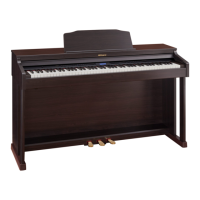5
°
Panel Descriptions
Pedal
[L] button
To turn the power on, press the [L]
button.
To turn the power o, long-press the [L]
button.
* Never disconnect the power cord while the screen
indicates “Don’t disconnect the power.”
* Before turning the piano on/o, always be sure to turn the volume down.
Even with the volume turned down, you might hear some sound when
switching the piano on/o. However, this is normal and does not indicate
a malfunction.
Headphone Hook
Whenever you are not using the headphones, you can
hang them on the headphone hook.
* Don’t hang anything other than headphones on this hook, and don’t
apply excessive force to it. Doing so may damage the headphone hook.
Bottom Panel
Connect headphones or an audio player to these jacks (left side).
You can use a USB cable to connect the piano to a computer, or
connect a USB ash drive (rear).
page
25
Adjusting the adjuster
Depending on the conditions of use or the environment in
which the piano is placed, the adjuster might move upward
over time, causing an abnormal sound to be heard when you
press the pedal. If this occurs, adjust the adjuster.
Adjustment method
Lower the adjuster located below
the pedal board, adjusting it so that
it contacts the oor. If the piano
is placed on carpet, lower the adjuster a little more so that it
pushes slightly against the oor.
Front Panel
To operate the piano, use the buttons to select an
item shown in the screen.
page
6
* When operating the pedal, take care not to pinch your ngers between the moving part and the
body of the unit. Pay special attention to this when using the unit where children are present.
Concerning the Auto O function
The power to this unit will be turned o automatically after
a predetermined amount of time has passed since it was last
used for playing music, or its buttons or controls were operated
(Auto O function).
If you do not want the power to be turned o automatically,
disengage the “Auto O” function (p. 24).
5 Any settings that you are in the process of editing will be lost
when the power is turned o. If you have any settings that you
want to keep, you should save them beforehand.
5 To restore power, turn the power on again.
Damper Pedal
Use this pedal to sustain the sound. While this pedal is held down, notes will be sustained for an
extended time even if you release your ngers from the keyboard.
This reproduces the following features of an acoustic piano’s damper pedal.
5 A change in feel as you press the pedal, initially light but becoming heavier as you continue
pressing
5 Richness and spaciousness added by other strings sympathetically resonating with the sound
of the notes you play
5 The distinctive decay added by “half-pedaling,” in which the core of the sound ends quickly
while leaving only a rich spaciousness and resonance
Sostenuto Pedal
The notes you are pressing when this pedal is depressed will be sustained.
Soft Pedal
This pedal is used to make the sound softer. Playing with the soft pedal depressed produces a
sound that is not as strong as when otherwise played with the equivalent strength. This is the
same function as the left pedal of a grand piano. The softness of the tone can be varied subtly by
the depth to which you press the pedal.

